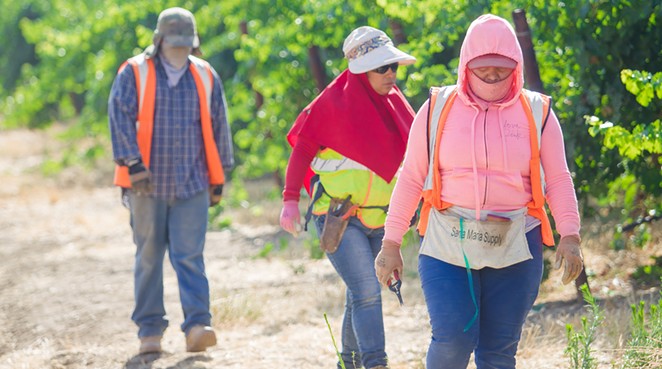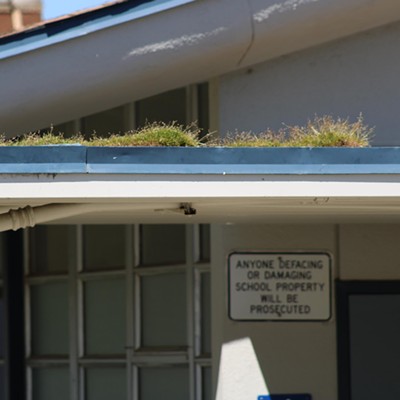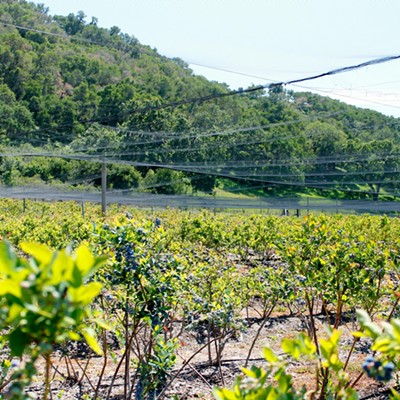Broccoli contributed $86.7 million of Santa Barbara County’s $1.8 billion agriculture industry in 2023, sitting in fourth place among the county’s top 10 agricultural commodities, according to the 2023 Santa Barbara County Crop and Livestock Report.
It’s also a crop that growers use dimethyl tetrachloroterephthalate (DCPA or Dacthal) on for weed treatment—an herbicide that was recently suspended by the U.S. Environmental Protection Agency (EPA) due to its health impacts on those exposed to it for long-periods of time, particularly pregnant women. The decision made history as the first time in 40 years that the EPA suspended a product.
Farmworker advocacy groups, including the Central Coast Alliance United for a Sustainable Economy (CAUSE), celebrated the EPA’s Aug. 6 decision as a victory to protect the health and well-being of field workers after advocating for the change for years.
“We’re very happy with [the decision], but it also highlights how a lot of the safety of our farmworkers is dismissed,” CAUSE Senior Policy Advocate Erica Diaz-Cervantes told the Sun. “There needs to be better policies to protect the safety of the farmworker community as they have been working through these hurdles.”
Growers and operators trust the EPA’s decision and work to comply with regulations, but there are concerns about identifying safe and effective alternatives for specialty crops on the Central Coast without risking the crop health, said Claire Wineman, the president of the Grower-Shipper Association of Santa Barbara and San Luis Obispo Counties.
“Of course, safety is the top priority, and we comply with the regulatory requirement, and I think … it highlights the extensive and robust regulatory process that’s in place and articulating the need for safe and effective products to grow produce,” she said.
In 2022, California applied more than 65,000 pounds of DCPA to broccoli (making up 35 percent of the state’s use), according to a May 2024 report from the California Department of Pesticide Regulation.

Santa Barbara County ranked fifth in the herbicide’s use, applying 10,955 pounds in 2022, an increase from 7,833 pounds in 2021, the report stated. SLO County sat just behind at 10,435 pounds applied in 2022.
EPA research indicated that pregnant women exposed to DCPA could experience changes to fetal thyroid hormone levels, and their babies could have low birth weight, impaired brain development, decreased IQ, and impaired motor skills later in life—some of which may be irreversible, according to the EPA.
“Based on current labels, some pregnant individuals could be subjected to exposures from 10 to 1,500 times greater than what is considered safe,” according to the EPA.
Countywide there are more than 32,000 migrant and seasonal agricultural workers, with an estimated 3,000 to 4,000 who are women of reproductive age (between 18 and 49), according to a 2023 UC Santa Barbara and UCLA evaluation report that studied farmworker maternal health.
“Just hearing about the backfall in that herbicide was something that is very big news, and the fact they took initiative to say, ‘Stop using this,’” CAUSE Senior Policy Advocate Diaz-Cervantes said. “A lot of mothers have expressed developing health symptoms, concerns that it was exposure to pesticides, children with health issues. A lot of times, parents were not being validated.”
CAUSE has worked with San Francisco-based advocacy and research organization Center for WorkLife Law to advocate for more regulation around pesticide use, she said.
“Overall our mission is to support farmworkers and secure a workplace and paid leave not only during pregnancy, but while breastfeeding,” Diaz-Cervantes said. “A lot of mothers have found it challenging. Before having babies, they take their clothes off and put it in a whole separate laundry bag. It’s different when chemicals are on your skin and you’re trying to nurse your baby.”
Diaz-Cervantes said she wants to see continued efforts to protect the health and safety of farmworkers, proper regulation enforcement and continued investigations into other chemicals involved in agriculture practices.
“Right now, we are really making sure farmworkers’ voices are being heard, connecting to elected officials who can push these issues, sharing experiences, and showing urgent need to go through this pesticide list and eliminating the ones that are proven to be extremely harmful to our community,” she said.
Santa Barbara County Agricultural Commissioner Jose Chang has never been in a situation where a product has been taken off the market like DCPA, he told the Sun.
The Santa Barbara County Agricultural Commissioner’s Office regulates pesticide use at a local level by enforcing state and federal regulation requirements, conducting fieldwork inspections, and requiring growers to apply for a private applicator certification and submit pesticide reports on a regular basis.
“Products are constantly being evaluated, and this to me is an indication that the systems in place—it’s not perfect by any means, [but for] those people who are concerned with pesticides, this is a way or them to know that the system may not work in the way they want to, but I think it’s working in the way that it’s intended to be,” Chang said.
Santa Barbara County first learned that the EPA was considering a DCPA suspension in April. The county then identified “a handful of farmers” who use the herbicide or that used it in the last two years and informed them that they cannot use the product anymore. The county also provided a list of alternatives from California Department of Pesticide Regulation.
“Obviously we are going to follow up with the handful of farmers identified in the past two years or are using it. One of the things we typically do is headquarter inspections: These types of inspections [are] when we look at pesticide storage and those using it to make sure they don’t have it in store,” Chang said. “Something else we do on a daily basis is have staff out in the field monitoring the use of pesticides. Ag biologists will be out in the field, and they are aware of [DCPA].”
While Santa Barbara is one of the top five DCPA users in the state, Chang said that he doesn’t see the suspension being an issue for broccoli growth in the county because of the state-provided list of alternatives.
“I don’t foresee that being an issue, but there are other ways the growers can use ... mechanical control or manually pulling weeds out. I don’t see this being a very big impact especially because it’s only a handful of farmers using it,” Chang said.
While Santa Barbara County applied 10,955 pounds of CDPA, Monterey County applied 79,000 pounds of DCPA in 2022, followed by Imperial County at 26,047 pounds.
Grower-Shipper Association President Wineman commended the county’s early action to inform growers, adding that while there are alternatives, it’s a slow approval process and not often available to specialty crops on the Central Coast. She said it’s important to have more tools available to mitigate weeds to meet buyer needs and prevent diseases.
“That’s why an herbicide is important because you need crops that meet consumer and buyer standards, and pests and diseases can be vectored to other crops. Instead of managing weeds effectively, you have weeds in other food crops as well,” Wineman said.
Neighboring Monterey County’s lettuce industry suffered an estimated $150 million loss in 2022 due to weeds hosting the impatiens necrotic spot virus spreading across the valley, according to the Salinas Valley Tribune. The virus causes yellowing and stunting that can make lettuce unfit for market.
“It’s an example of the role of proper weed management in overall crop health,” Wineman said. “It’s helpful to have a variety of tools in the tool box. With fewer products, you have potential resistance issues … one type of product can create superbugs.”
Moving forward, Wineman’s concern is the cumulative effect of being able to address challenges like herbicide resistance.
“There is an ongoing commitment to advancement and improving technologies, but those solutions take time, aren’t always effective, and aren’t feasible for the small and medium growers to be able to pursue those alternative technologies,” Wineman said.
Reach Staff Writer Taylor O’Connor at [email protected].














